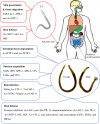Twenty-five-year research progress in hookworm excretory/secretory products
- PMID: 32171305
- PMCID: PMC7071665
- DOI: 10.1186/s13071-020-04010-8
Twenty-five-year research progress in hookworm excretory/secretory products
Abstract
Hookworm infection is a major public health problem that threatens about 500 million people throughout tropical areas of the world. Adult hookworms survive for many years in the host intestine, where they suck blood, causing iron deficiency anemia and malnutrition. Numerous molecules, named excretory/secretory (ES) products, are secreted by hookworm adults and/or larvae to aid in parasite survival and pathobiology. Although the molecular cloning and characterization of hookworm ES products began 25 years ago, the biological role and molecular nature of many of them are still unclear. Hookworm ES products, with distinct structures and functions, have been linked to many essential events in the disease pathogenesis. These events include host invasion and tissue migration, parasite nourishment and reproduction, and immune modulation. Several of these products represent promising vaccine targets for controlling hookworm disease and therapeutic targets for many inflammatory diseases. This review aims to summarize our present knowledge about hookworm ES products, including their role in parasite biology, host-parasite interactions, and as vaccine and pharmaceutical targets and to identify research gaps and future research directions in this field.
Keywords: ES products; Hookworm; Host-parasite interactions; Therapy; Vaccine.
Conflict of interest statement
The authors declare that they have no competing interests.
Figures
References
Publication types
MeSH terms
Substances
Grants and funding
LinkOut - more resources
Full Text Sources


